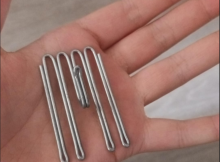Have you ever stumbled upon a curious metal object while rummaging through your drawers, particularly among your sewing supplies? It may appear unassuming at first, with its simple and utilitarian design, but it serves a very specific purpose that might surprise you. This unsung hero of mechanical systems is known as the cotter pin, and it plays a crucial role in securing and maintaining a wide range of devices, from automotive parts to sewing machines.

The metal hook-like items you found are called cotter pins (also known as split pins). These fasteners are used to secure bolts or other hardware components and prevent them from loosening due to vibrations or other forces. Cotter pins consist of a looped end and a split shaft, which is bent back after being inserted through a pre-drilled hole.
When used, a cotter pin is inserted through a hole in a bolt, shaft, or similar hardware component. Once the pin is in place, the split ends are bent outward, locking the pin and preventing it from slipping out. This simple yet effective mechanism makes cotter pins invaluable in various mechanical applications, from automotive repairs to machinery assembly.
Finding a cotter pin among your sewing supplies might seem odd, but there are practical reasons for its presence. Occasionally, cotter pins are used in sewing machines to secure various moving parts, like the needle clamp or presser foot. Additionally, those who engage in crafts that combine fabric and hardware might keep these pins on hand for making customized accessories or home decor items.
Beyond the sewing room, cotter pins are widely used in the automotive and machinery repair industries. They are essential for securing components such as steering linkages, wheel bearings, and other critical parts that need to remain firmly in place, even under intense vibrations and stress. Mechanics and technicians rely on cotter pins to ensure the safe and reliable operation of vehicles and equipment.
The versatility of cotter pins extends beyond industrial and automotive applications. Crafters and DIY enthusiasts often use them in a variety of creative projects, from customizing furniture to making unique jewelry and accessories. The ability to easily insert and secure these pins makes them a valuable tool in the world of DIY.
Cotter pins also have applications in the great outdoors. Campers, hikers, and outdoor enthusiasts may use them to secure equipment, such as tent poles, kayak paddles, or even fishing rod components. Their durability and resistance to the elements make them a reliable choice for outdoor gear.
Regardless of the specific application, cotter pins play a vital role in maintaining the integrity and safety of mechanical systems. They ensure that critical components remain firmly in place, preventing costly and potentially dangerous failures. As such, these humble fasteners are essential for the smooth and reliable operation of a wide range of devices, from sewing machines to heavy-duty machinery.
Next time you come across a metal hook-like item in your sewing supplies or toolbox, you’ll know that it’s more than just a random piece of metal. Cotter pins are small but essential tools that play a critical role in securing and maintaining mechanical systems, whether in a sewing machine or more complex machinery. So, even if you don’t need them for your sewing projects, it might be worth keeping a few on hand for other household tasks and DIY projects. Who knows, you might just discover a new use for these unsung heroes of the mechanical world!

